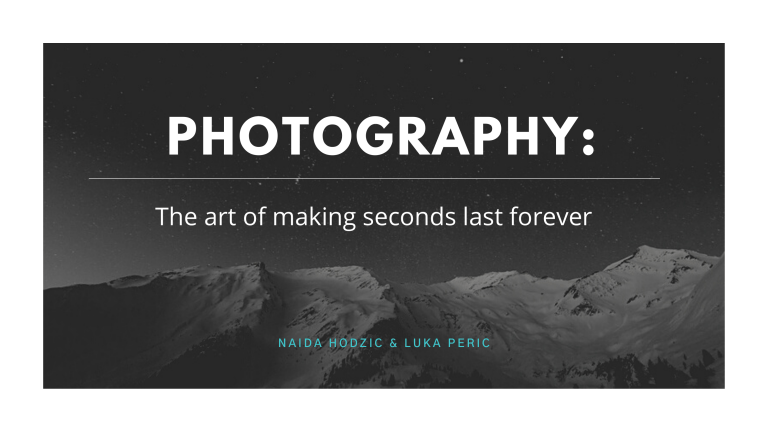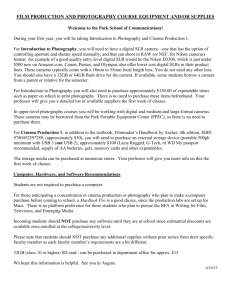
PHOTOGRAPHY: The art of making seconds last forever NAIDA HODZIC & LUKA PERIC WHAT WE'RE GONNA LEARN TODAY? 1. What is photography? 2. History of photography 3. Camera types and camera body 4. Practical photography 5. How to pose: do and don't do 6. Telling stories with photography 7. ... The word "photography" comes from two old Greek words: "phos" meaning "light" & "graph" meaning "to draw" THE BASIC CONCEPT OF PHOTOGRAPHY HAS BEEN AROUND SINCE ABOUT THE 5TH CENTURY B.C.E. It wasn't until an Iraqi scientist developed something called the camera obscura in the 11th century that the art was born. IT WAS NOT UNTIL THE 17TH CENTURY THAT THE CAMERA OBSCURA BECAME SMALL ENOUGH TO BE PORTABLE. Basic lenses to focus the light were also introduced around this time. The First Permanent Images Photography, as we know it today, began in the late 1830s in France. Joseph Nicéphore Niépce used a portable camera obscura to expose a pewter plate coated with bitumen to light. Indeed, it was in Paris that the first picture of a human being has been taken. A work that we owe to Louis Daguerre, taken in Paris in 1838. One of the oldest photographic portraits known, 1839 or 1840,[30] made by John William Draper of his sister, Dorothy Catherine Draper Beyond the many stories that have built the Presentations are communication tools that legend of Paris, the capital also contributed to scientific innovations. can be used as demonstrations. Cameras for everyone! Steven J. Sasson, inventor of the first digital camera, comparing his device with today's digital cameras. SMART CAMERAS & DIGITAL AGE Introducing Smart Cameras In the late 1970s and early 1980s, compact cameras that were capable of making image control decisions on their own were introduced. The Digital Age In the 1980s and 1990s, numerous manufacturers worked on cameras that stored images electronically. The first of these were point-and-shoot cameras that used digital media instead of film. There are four main types of digital camera: compact, bridge, DSLR and mirrorless cameras. DSLRs and mirrorless models have interchangeable lenses. The type you go for will depend on a number of factors, including what you want to photograph or film, how portable you want it to be and the image quality you're looking for. Compact camera Bridge camera Mirrorless camera HOW TO PICK THE RIGHT CAMERA LENS TO FIT YOUR NEEDS? What Are the Different Parts of a Camera Body? Practical photography guide How do you actually take good photos? GRID LINES Parallel lines have so much in common. It's a shame they will never meet. RPA Summer 2020 The rule of thirds is one of the most powerful techniques, to help you position different elements in the photo. Most modern smartphone cameras now can overlay the lines over the screen before taking the photo. These are referred to as either grids or gridlines - and they do not appear on the photo! Alternatively you can use the Golden ratio. The golden ratio is extraordinary because it can be visualized in every aspect of life, from the human body to famous works of art and everything in between. Although this mathematical existed independently of humankind long before recorded history, artists started using it as a basis for compositions in the 1500s. Renaissance artists began calling it the golden ratio or the divine proportion because of its ability to achieve balance and beauty. DON'T CUT (always) There was a guy who got his entire left side cut off. Don’t worry, he is all right now. RPA Summer 2020 A great photo is a combination of factors that work together to produce a great final image. The subject, lighting, composition, focus, and timing are all key to capturing a great image. However, one aspect that is often overlooked is how the image is cropped, as this can have a huge impact on the final photo. BREATHING SPACE What do you call two dogs breathing heavily? A pair of pants. RPA Summer 2020 Breathing room or negative space photography is the area surrounding the main subject in a photo that is left unoccupied. Put simply, it is the space around the object itself that helps define the positive space (or main focus). In other words, subject in the image in this type of composition is sometimes referred to as positive space photography. Light balance Light doesn't have any mass. If it did, then it would've been called heavy. RPA Summer 2020 Leading lines I don't have a joke for this section 😁 RPA Summer 2020 Leading lines are lines that appear in a photograph that have been framed and positioned by the photographer to draw the viewer's eye towards a specific point of interest. These lines often draw the viewer’s eye in a specific direction or towards a designated portion of the photograph. Be creative! How many photographers does it take to change a light bulb? 50. One to change the bulb, and forty-nine to say, “I could have done that!” RPA Summer 2020 To sum up... RPA Summer 2020 GRID LINES DON'T CUT (always) BREATHING SPACE LIGHT BALANCE LEADING LINES BE CREATIVE




